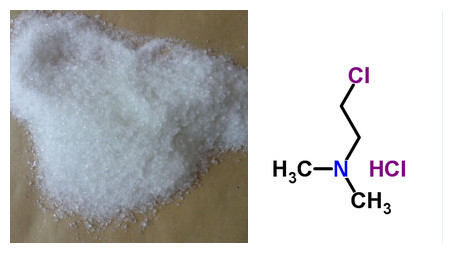| | 2-Dimethylaminoethyl chloride hydrochloride Chemical Properties |
| Hazard Codes | T,N,T+ | | Risk Statements | 22-24-36/37/38-68-51/53-26 | | Safety Statements | 26-36/37-45-61-36/37/39-28A | | RIDADR | UN 2811 6.1/PG 3 | | WGK Germany | 3 | | RTECS | KQ9020000 | | Autoignition Temperature | 220 °C | | TSCA | Yes | | HazardClass | 6.1 | | PackingGroup | III | | HS Code | 29211980 | | Toxicity | LD50 orally in Rabbit: 238 mg/kg LD50 dermal Rabbit 290 mg/kg |
| | 2-Dimethylaminoethyl chloride hydrochloride Usage And Synthesis |
| Appearance | 2-Dimethylaminoethyl chloride hydrochloride is white to Off-White Solid
 | | Applications | 2-Chloro-N,N-dimethylethylamine is a widely used as an intermediate and starting reagent for organic synthesis.
| | Dangerous Goods Info | Not a dangerous good if item is equal to or less than 1g/ml and there is less than 100g/ml in the package
| | Chemical Properties | Colorless to beige crystals | | Uses | 2-Chloro-N,N-dimethylethylamine hydrochloride (DMC) is used as intermediate for the synthesis of pharmaceuticals (e.g. bephenium hydroxnaphthoate, diltiazem, mepyramine and phenyltoloxamine). Product Data Sheet | | Uses | 2-Chloro-N,N-dimethylethylamine is a widely used as a intermediate and starting reagent for organic synthesis. Also acts as Intermediate for the syntheses of bephenium hydroxynaphthoate, diltiazem, mepyramine and phenyltoloxamine. | | Definition | ChEBI: 2-dimethylaminoethyl chloride hydrochloride is a hydrochloride obtained by combining 2-dimethylaminoethyl chloride with one molar equivalent of hydrochloric acid. It is a hydrochloride and an organoammonium salt. It contains a 2-dimethylammonioethyl chloride. | | Safety Profile | Poison by
intraperitoneal and subcutaneous routes.
Questionable carcinogen with experimental
neoplastigenic data. Mutation data reported.
When heated to decomposition it emits very
toxic fumes of Cland NOx |
| | 2-Dimethylaminoethyl chloride hydrochloride Preparation Products And Raw materials |
|



